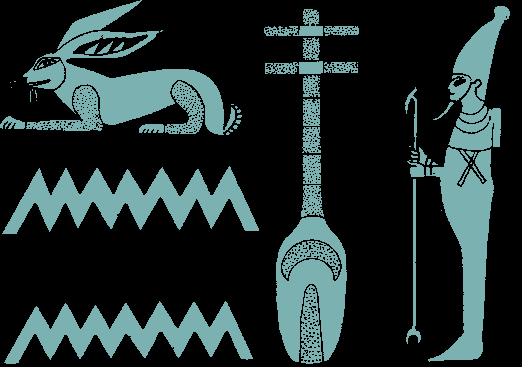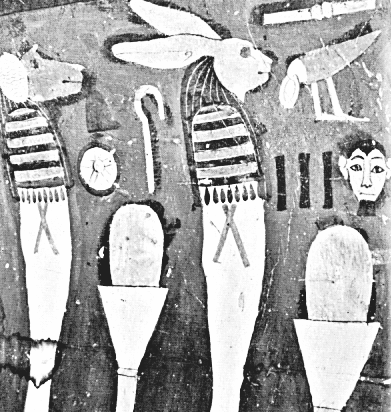
The similarities between the 'Rabbit-Gods' The Great Hare, the Jade Rabbit
and Wn:
-
A note: I look into the similarities between God-like and Rabbit-like heros
-
in this page. This is no substitute for reading up on them. In fact, I
recommend the library research as being more fun than say a resulting page.
In no way am I collecting pieces of various religions to form some 'absolute
truth,' although I certainly have found many truths in reading these stories.
You know what I mean. Anyway,
-
In all cultures the rabbit or hare has been an archetype of swift
action.
-
Many of us know of the Cherokee Rabbit and the Zambian rabbit Kalulu who
form the basis of Brer rabbit as well as Bugs' Bunny. In these tales we
see the rabbit as a messenger, running against the wind and chewing on
wood (a judgement
element) in his path. Many tales around the world show the competition
of the rabbit with beings of these elements as well as with other creatures.
Of particular interest is the story of the Tortoise and the Hare. Unlike
the Aisop fable in which the hare is a slacker, in the Cherokee and Zambian
tales (very similar to eachother) it is the tortoise who out-tricks the
rabbit by calling his relatives, who all look like him, and placing them
at various points along the track including right next to the finish line.
I have even heard tales where the race involves beer (rather than running)
as an end to tales like like Trickster
Rabbit. However, in the Korean version of the tale (different), the tortoise
tricks the rabbit into joining him into the sea so that the rabbit's eyes
may be used to cure the ill king of the sea. The rabbit in turn tricks
his captors that his real eyes are still on land and that these are just
spares. Taken to land, he escapes. Though different, the tales all have
important points about the nature of being clever and cunning.
-
Going back further are the more ancient versions of 'Rabbit-Gods.'
-
Throughout history the rabbit and moreover the hare (although present-day
pet rabbits have some hare in them) have sustained us through rough times,
especially cold and ice, and human kind has inevitably worshiped the hare
as a God far more clever than we--we take of its numbers and yet their
numbers never decrease. In nearly all cultures the hare has had a strong
relationship with the moon, under which they could be seen most often,
and with fire. The hare is known for conserving its energy, leaping only
as needed, and upon the scent of a forest fire will leap through the flames
to the protection of the already cindered trees rather than bother to outrun
the flames.

-
I have put 'Rabbit-Gods' in quotes because not all are entirely lagomorpha
-
(rabbit or hare) and not all are entirely Gods. Wn, for example, though
the hyroglyph for hare, was seen in only one inscription as a God (bellow).
Wn (a jack-rabbit atop a single ripple of blue-green energy, above) means
'to exist' (The full phrase above means 'the perfect being'). Indeed, the
hare's existence--the dependence upon cleverness to escape predators--clearly
resembles our own.

-
Gluskap
(also Glooscap),
whos name means 'Liar,'
-
was a giant of Native American folklore, an immortal (indicated by his
stone eyebrows). Like most (non-European) giants, he was huge (at his will
tall enough for lightning to dance upon his head), intelligent, green,
a conserver of energy and magic who did his best to use it for the good
of all. Gluskap in particular was known for offering unending food as well
as immortalizing a few choice onlookers as natural statues. More importantly
he founded new lands and made the seasons and animals, destroying the giant
beasts that once ruled the earth. In this his legends parallel those of
the Great Hare, his predecessor. It is thought that the legends in part
represent early archeology, a reference to early
mammals (such as lagotherium, an egg-laying rabbit-rat) out-surviving the
Dinosaurs.
-
In some respects Gluskap and the Great Hare resemble
the Druidic Dagda
-
(God of the animals--Shiva in ancient Hindu) Commanding hound(s), the giver
of life as well as the overseer of the afterlife, is the reason for the
warm seasons as is the Great Hare. The original Hindu Moonhare God, Soma/Chandra,
(the wine or vinegar of the Gods who granted them immortality and saw through
the Gods, chanted as a-Chanr) is thought to have be related to Rabbits
Gods and/or their consorts: Chang-O(China), Ix-Chel(Mayan), Ishtar(Babel)
and Ostara(Wiccan/Nordic) Ostara's celebration lives on in Easter
in the same way that Imbolc lives on in Ground-Hog Day (these holidays
being not so well preserved and the Druidic
Samhain or Holloween).
-
A God called Bel existed in Babylonian/Sumarian religion. A trickster
God
-
thought to be another name for Marduk, the central God of Babylonia. Though
cherub-like, the Babylonian Bel is not entirely lagomorpha either. Like
the similarity of the lunar Druidic and lunar Babylonian astrology, it
is thought that both Gods are called Bel by coincidence, despite the common
linguistic and religious origin of both cultures.
-
This common origin is thought to have been near what is now Mongolia
and Southern
-
Russia, the common source of all Indo-European languages and religions.
This is also the origin of the Chinese Zodiac (the twelve animal archetypes
are related to both year, month and hour-pairs, and in being related to
month roughly subsume the Western Zodiac, although their element-types
cycle differently, being taken from Egyptian and Babylonian religion),
as well as Taoism. The rabbit is central to the Zodiac having helped the
Bhudda's passage into the afterlife. In Bhudism the rabbit does this by
sacrificing himself into a fire as a last meal. Taoism,
however, having taken wisdom from over 4000 years ago, believes in sacrifice
without injury to the Self, and developed the idea of the rabbit in the
moon (also an important myth in Japan). This rabbit, called the Jade Rabbit,
grinds the Jade Elixir, an herbal source of immortality, in the moon. The
Jade Rabbit embodies much of what the Tao preaches; The lagomorpha conserves
its energy until it truely needs to leap away, leaving time and energy
for racing and circling and other fun activities. The Mayans,
also, saw a rabbit in the moon with
an accompanying goddess.
Ubasti the Cat Goddess

-
The cat has always been seen as a creature of raw emotion, silence, and
speed--
-
competing with wind as does the rabbit. A poet
once wrote:
Cats,
no less liquid than their shadows,
offer no angles to wind.
They slip, diminished,
neat,
through loopholes less than themselves.
-
The snow leopard and the lynx are the only animals to have fur on the bottom
of their feet besides lagomorpha. In fact, in ancient Hindu belief, it
was Shiva who brought the tiger into being to punish mankind's growing
fearlessness.
-
But it was more the rabbit that was considered a kind of cat than the other
way
-
around. Rabbits were often called cats of the thicket. But no baud could
hunt the rats of Egypt as did the reed cats. These cats kept rat populations
under control, saving human food and life.
-
Few cultures worshiped the cat as did the Egyptians.
-
If ones cat died it was traditional to shave ones eyebrows in mourning.
Further, killing a cat was a capital offense. Ubasti (also Eubasti, Bastet,
Bast), the goddess of compassion and happiness was originally Sakhma, the
lioness goddess. Adoptive mother of the moon, she could be the eye-of-Ra,
an instrument of punishment. (Often lions were associated with the sun
because of the mane.)
-
Just looking at the hyroglyph alphabet one can see their reverence. The
word Wn
-
can mean both hare and flower (perhaps Vinca Rosea though they usually
have five rather than four pedals), while in contrast there are over four
feline hyroglyphs, including Miw, Rw, L, and two special hyroglyphs, Hst
for the front end of the cat and Ph for the back end.
Back to the Way of the Rabbit!
![]()




